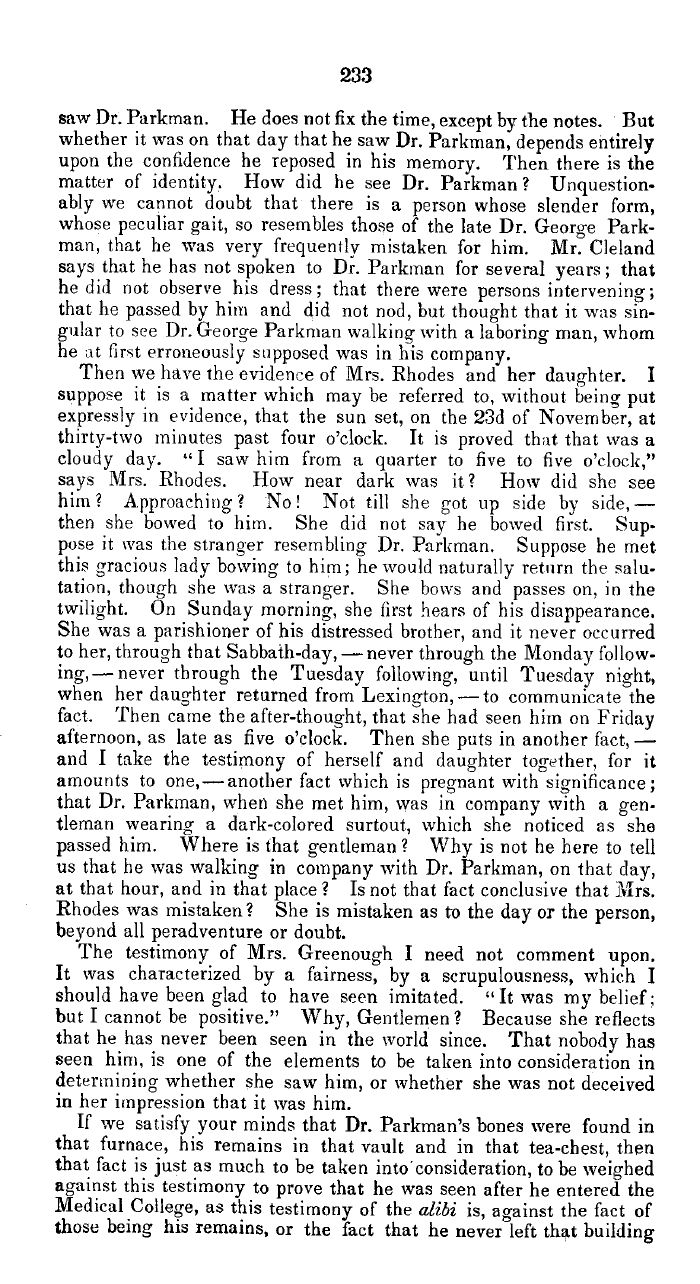|
233
saw Dr. Parkman. He does not fix the time, except by the notes. But
whether it was on that day that he saw Dr. Parkman, depends entirely
upon the confidence he reposed in his memory. Then there is the
matter of identity. How did he see Dr. Parkman ? Unquestion-
ably we cannot doubt that there is a person whose slender form,
whose peculiar gait, so resembles those of the late Dr. George Park-
man, that he was very frequently mistaken for him. Mr. Cleland
says that he has not spoken to Dr. Parkman for several years; that
he did not observe his dress; that. there were persons intervening;
that he passed by him and did not nod, but thought that it was sin-
gular to see Dr. George Parkman walking with a laboring man, whom
he at first erroneously supposed was in his company.
Then we have the evidence of Mrs. Rhodes and her daughter. I
suppose it is a matter which may be referred to, without being put
expressly in evidence, that the sun set, on the 23d of November, at
thirty-two minutes past four o'clock. It is proved that. that was a
cloudy day. "I saw him from a quarter to five to five o'clock,"
says Mrs. Rhodes. How near dark was it? How did she see
him? Approaching? No! Not till she got up side by side,-
then she bowed to him. She did not say he bowed first. Sup-
pose it was the stranger resembling Dr. Parkman. Suppose he met
this gracious lady bowing to him; he would naturally return the salu-
tation, though she was a stranger. She bows and passes on, in the
twilight. On Sunday morning, she first hears of his disappearance.
She was a parishioner of his distressed brother, and it never occurred
to her, through that Sabbath-day,-never through the Monday follow-
ing,-never through the Tuesday following, until Tuesday night,
when her daughter returned from Lexington,-to communicate the
fact. Then carne the after-thought, that she had seen him on Friday
afternoon, as late as five o'clock. Then she puts in another fact,-
and I take the testimony of herself and daughter together, for it
amounts to one,-another fact which is pregnant with significance;
that Dr. Parkman, when she met him, was in company with a gen-
tleman wearing a dark-colored surtout, which she noticed as she
passed him. Where is that gentleman? Why is not he here to tell
us that he was walking in company with Dr. Parkman, on that day,
at that hour, and in that place ? Is not that fact conclusive that Mrs.
Rhodes was mistaken? She is mistaken as to the day or the person,
beyond all peradventure or doubt.
The testimony of Mrs. Greenough I need not comment upon.
It was characterized by a fairness, by a scrupulousness, which I
should have been glad to have seen imitated. "It was my belief;
but I cannot be positive." Why, Gentlemen ? Because she reflects
that he has never been seen in the world since. That nobody has
seen him, is one of the elements to be taken into consideration in
determining whether she saw him, or whether she was not deceived
in her impression that it was him.
If we satisfy your minds that Dr. Parkman's bones were found in
that furnace, his remains in that vault and in that tea-chest, then
that fact is just as much to be taken into consideration, to be weighed
against this testimony to prove that he was seen after he entered the
Medical College, as this testimony of the alibi is, against the fact of
those being his remains, or the fact that he never left that building
|

